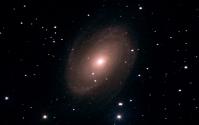Strongly Celestial Looking outward; looking backward in time... |
|||
 |
|||
Planet Gallery These are my pictures of the planets in our solar system. As with all of my galleries, click on the picture itself to bring up a larger, scaleable copy of the picture in a separate window; be sure to expand that window to see the full size of the image! |
||
Subject: Saturn Equipment: Comments |
||||
Subject: Jupiter Equipment Comments |
||||
Subject: Jupiter Equipment Comments
|
||||
Subject: Jupiter and moons Equipment Comments Io orbits Jupiter fastest at 1.7 days to make the trip around the planet. Europa takes 3.5 days, Ganymede 7.1 days, and Callisto takes longest at 16.7 days. Note that Jupiter itself is washed out in this image because I exposed it long enough to clearly pick up the moons. |
||||
Subject: Jupiter and moons Equipment Comments Fun fact: Io, the inner most moon, is the most volcanic object in our solar system. The tremendous tidal force caused by its close orbit around Jupiter "flexes" the surface, causing internal friction which generates heat and forms volcanos. There are >400 active volcanos on the surface of Io! |
||||